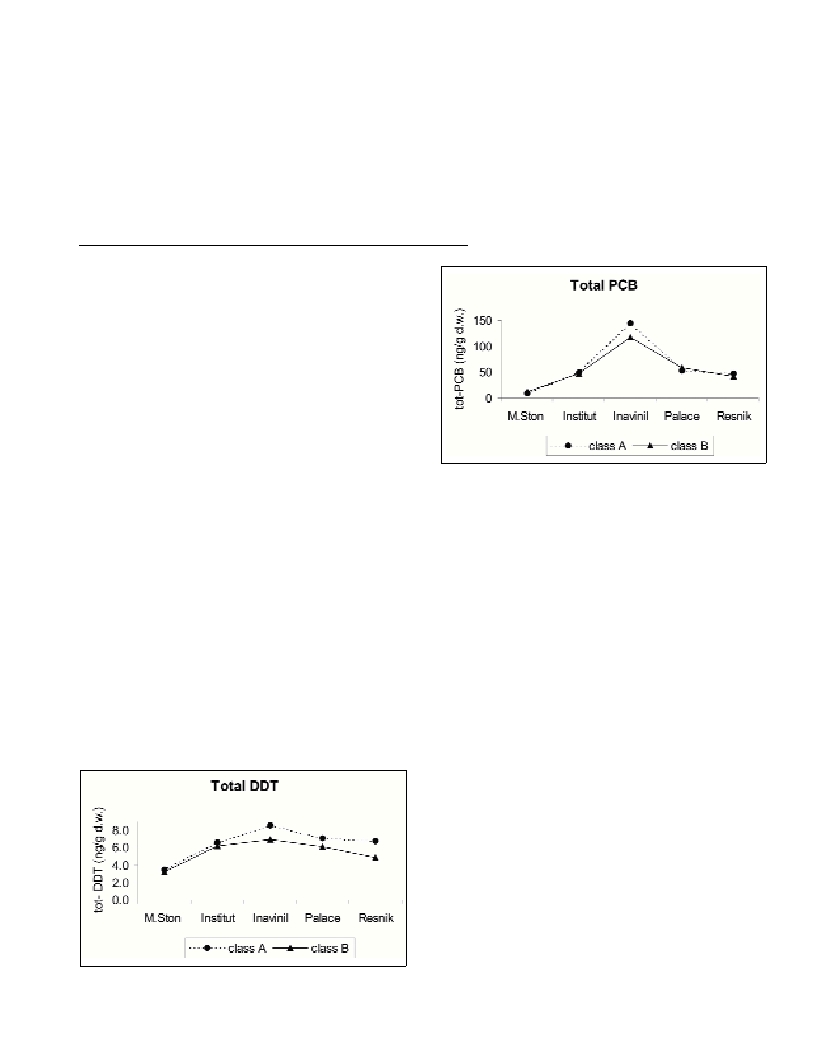Rapp. Comm. int. Mer Médit., 37,2004
226
MUSSELS (MYTILUS GALLOPROVINCIALIS)AS BIOINDICATOR OF CHLORINATED HYDROCARBONS
POLLUTION IN THE KASTELA BAY (ADRIATIC SEA)
V. Milun*, T. Zvonaric, A. Baric
Institute of Oceanography and Fisheries, Setaliste I.Mestrovica 63, 21000 Split, Croatia - *milun@izor.hr
Abstract
Significantly increased values of chlorinated hydrocarbons in mussels (Mytilus galloprovincialis) transplanted to the Kastela Bay show a
certain level of the pollution of the Kastela bay with organochlorines. The PCBs higher values undoubtedly indicate the presence of indus-
trial wastewaters in the investigated area. An inverse relationship between chlorinated hydrocarbons concentrations in mussels and the spe-
cimen length was found. The comparison of the concentration of extractable organic matter to chlorinated hydrocarbons concentrations
show a limited corellation. However, the detailed interpretation of the obtained results in terms of physiological effects is not yet possible
because of the small number of analysis.
Key words: Adriatic Sea, mussel, chlorinated hydrocarbons, PCBs, pesticides
Introduction
Chlorinated hydrocarbons are ubiquitous contaminants in the coas-
tal areas. To provide reable information on the contaminant presence
in the environment, mussels have traditionally been used as good bio-
logical indicators of the sea pollution. However, the degree to which
the organochlorines are accumulated by mussels depends not only on
their concentrations in the external environment, but also on internal
biological factors (e.g. age, size, reproductive cycle). The present
study was designed to monitor patterns of bimonthly accumulation of
chlorinated hydrocarbons in mussels over a one-year period in the
area of Kastela Bay. In this paper, we report the results of only one
sampling done in January 2002.
Materials and methods
Two size classes of mussel Mytilus galloprovincialis (class A: ~5
cm shell length and class B: ~6 cm shell length) were transferred from
the clean area of the Mali Ston Bay to four experimental stations in a
relatively polluted area of the Kastela Bay in November 2001. After
two months of the exposure to the ambient conditions, mussel samples
were taken for an analysis. Chlorinated pesticides (DDE, DDD, DDT)
and polychlorinated biphenyls (Arochlor 1254, Arochlor 1260)
(PCBs) were determined by the capillary gas chromatography with an
electron capture detector (1).
Results and discussion
The obtained results show a significant increase of the concentra-
tion of chlorinated hydrocarbons in the mussels. The mean concentra-
tion of chlorinated pesticides increased from 3.5 to 7.3 ng/g d.w.
(class A) and 3.2 to 6.0 ng/g d.w. (class B), respectively (Fig.1).
PCBs show even higher tendency of increase at all investigated sta-
tions. The mean concentration of total PCBs increased from 9.6 to
73.6 ng/g d.w. (class A) and 12.4 to 66.3 ng/g d.w. (class B), respec-
tively (Fig.2). The overall data on chlorinated hydrocarbons show
that PCBs predominate in all mussels at all investigated stations over
DDT compounds. Moreover, the change of total DDT concentrations
between sampling stations is less pronounced than that shown for total
PCBs. Regarding the investigated area, the spatial distribution of both
groups of compounds is basically similar. The highest amount of chlo-
rinated pesticides and PCBs was found at the Inavinil station located
in the eastern part of the Kastela Bay, which is under the strong impact
of industrial wastewater and urban runoff.
Fig. 1. Concentration of total DDT compounds in two size classes of mus-
sels at sampling stations.
Fig. 2. Concentration of total PCBs in two size classes of mussels at sam-
pling stations.
Regarding the length of collected mussels, we have found general-
ly higher concentrations of chlorinated hydrocarbons in smaller mus-
sels (class A), which is in accordance with the previously published
results indicating the tissue concentrations decrease with increasing
body size (2).
The extractable organic matter (EOM) content expressed on a dry
weight basis, is not significantly different between the mussel classes
and investigated stations. The highest value of EOM and chlorinated
hydrocarbons we have found is at the Inavinil station. Limited corre-
lation between PCBs concentration and EOM was found, which sug-
gests that variation in the mussels’lipid cycle might be responsible for
some of the variations of the organochlorines concentrations (3).
In conclusion, the analysis of mussels Mytilus galloprovincialis
from the Kastela Bay clearly demonstrate a quite low level of pollu-
tion by DDT and PCBs compounds in the Bay. Moreover, the obtai-
ned results are lower than those previously reported in literature (4).
References
1-UNEP/IOC/IAEA,1988. Determination of DDTs and PCBs by capilla-
ry gas chromatography and electron capture detector. Reference Methods
for Marine Pollution Studies, No.40, UNEP.
2-Gilek M., Björk M., and Näf C:, 1996. In?uence of body size on the
uptake, depuration, and bioaccumulation of polychlorinated biphenyl
congeners by Baltic Sea blue mussels, Mytilus edulis. Mar. Biol.,125:
499-510.
3-Marchand M., Vas D., and Duursma E.K., 1976. Levels of PCBs and
DDTs in mussels from the N.W.Mediterranean. Mar. Poll. Bull.,7: 65-69.
4-UNEP 1994. Monitoring programme of the eastern Adriatic coastal
area, Report for 1983-1991, MAP Technical Report Series No.86, Athens,
135 p.

